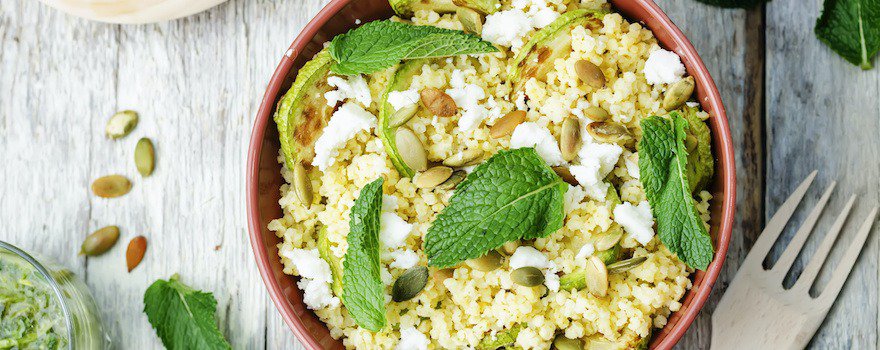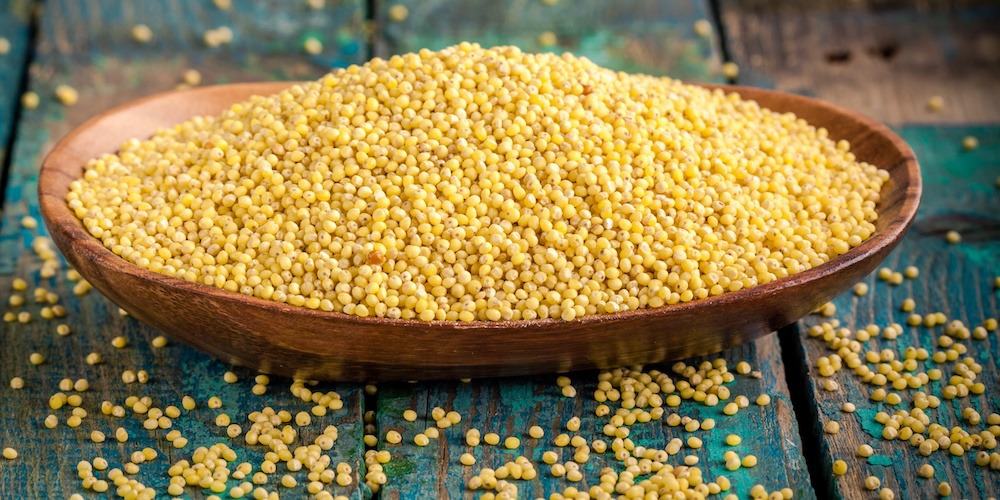BENEFITS OF MILLET
✓ Source of plant-based proteins
✓ Antioxidant
✓ Improves diabetes
✓ Helps with weight loss
✓ Potentially anti-cancer
✓ Enhances hair beauty
What is millet?
“Millet” is a general term that refers to several plants in the grass family. It includes common millet (Panicum miliaceum), bird millet (Setaria italica), finger millet (Eleusine coracana), and pearl millet (Pennisetum glaucum), which is the best known.
It is often confused with sorghum, another plant in the grass family.
Also called “petit mil,” it is one of the oldest cereal grains cultivated by humans.
The first traces of its domestication date back to around 4,800 years ago. The plant grows in the dry regions of Africa (Mali, Nigeria…) and Asia (India, China…). It produces long spikes covered with seeds harvested in late summer.
Millet seeds are a staple food for local populations. They are rich in nutrients (proteins, fibers…) and prevent nutritional deficiencies. They also show antioxidant action, improve diabetes, and help with weight loss. Finally, they are potentially anti-cancer.
Even today, millet is one of the most important crops in India and Africa. This plant has the advantage of being drought resistant and growing in the most arid regions.
Like sorghum, it is considered a food of the future in response to climate change. According to the FAO (Food and Agriculture Organization of the United Nations), it is one of the solutions to the global food security problem.

Nutritional Composition
- Amino acids
- Vitamins: B1, B2, B5, B6, B9, E, K
- Minerals and trace elements: iron, magnesium, calcium, manganese, phosphorus, zinc
- Proteins
- Fibers
- Carbohydrates
- Lipids
- Antioxidant compounds: polyphenols, catechins, ferulic acid
The Benefits of Millet
🌿 Source of Plant-Based Proteins
The seeds provide about 11 g of protein per 100 g. Thus, they are among the best sources of plant-based proteins.
They are ideal for reducing meat consumption and avoiding protein deficiency. They are suitable for flexitarian, vegetarian, or vegan diets.
These proteins contain many amino acids, some of which are essential for the body. They notably include isoleucine, leucine, and methionine. Finally, millet is one of the rare plant foods to contain tryptophan.
This review from the Federal Rural University of Rio de Janeiro (Brazil) explored the food potential of pearl millet.
🥝 Antioxidant
The seeds contain various antioxidant compounds. Among them are polyphenols, catechins, and ferulic acid. The latter is also found in oats and buckwheat.
This molecule protects the body from free radicals and strengthens the natural defense mechanisms. It notably activates the protein Nrf2, which stimulates the production of glutathione and antioxidant enzymes in the body.
This review from Maharishi Markandeshwar University in Haryana (India) demonstrates the antioxidant action of ferulic acid.
🍭 Improves Diabetes
The consumption of millet seeds appears to have beneficial effects on type 2 diabetes (sugar diabetes). On the one hand, they contain soluble fibers. These reduce blood sugar levels, limit blood sugar spikes after meals, and improve insulin resistance.
On the other hand, they are rich in magnesium. Thus, 125 g of seeds are enough to meet 10% of the recommended daily needs. This mineral contributes to blood glucose regulation. It is essential for insulin action.
Finally, this cereal has the advantage of having a medium glycemic index (70).
This review from Aberystwyth University (UK) shows the beneficial effects of millet seeds on diabetes.
🏃🏻♂️ May help with weight loss
Due to its high content of soluble fibers, millet can help maintain a healthy weight or lose weight. In the stomach, its fibers swell and form a viscous gel, promoting satiety and limiting snacking throughout the day.
Its proteins also have a satiating effect. Additionally, by increasing metabolism, they promote fat burning.
Further studies are needed to confirm millet’s effectiveness in weight loss and obesity.
🔬 Potentially anti-cancer
The phenolic compounds it contains have anticancer potential. Through their antioxidant action, they eliminate free radicals that contribute to cancer development. At the same time, they inhibit cancer cell proliferation and induce their apoptosis (programmed cell death).
Studies have also shown its importance in treating hair loss (alopecia) induced by chemotherapy.
This study from San Gerardo Hospital in Milan (Italy), conducted on cancer patients, shows how common millet prevents hair loss.
🧝♀️ Enhances hair beauty
Millet enhances hair beauty by making it stronger and more resilient. The seeds contain miliacine, a natural compound that has a beneficial effect on hair bulbs.
They are also rich in vitamin E, which promotes hair growth and protects hair from free radicals.
Finally, they also contain zinc, which stimulates keratin production.
This study from DIVA Expertise (France), conducted on women, shows how miliacine enhances hair beauty.

How to consume millet?
Hulled millet seeds
To be consumed, the seeds must be hulled and freed from their very hard outer shell. They are then cooked like semolina or rice. They can be used to make vegetarian patties and balls, gluten-free couscous, risottos… They can accompany vegetable, meat, or fish dishes.
They have a mild taste reminiscent of nuts. You can also consume them in a sweet version, in desserts, mueslis, or bakery preparations.
Millet flour
Millet flour is a delicious gluten-free flour. Thus, it is an excellent alternative to wheat flour. It mainly has hazelnut notes. It is used for making crepes, waffles, cookies… and gluten-free bread.
Mix it with another gluten-free flour, like rice flour, up to 30%.
Millet flakes
Once hulled and washed, the seeds are steamed to obtain flakes. These are consumed like oat flakes. Add them to mueslis, cereal bars, patties, yogurts…
Their fairly neutral taste allows for many sweet or savory recipes.
Millet milk
It is a plant-based drink, gluten-free and lactose-free. The seeds are soaked in water for several hours. The preparation is then drained and blended to obtain a creamy texture.
Millet milk can be consumed cold or hot. Pour it over your cereals or use it for your pastry and bakery preparations.

Consume sustainably: prioritize local, organic, and fair-trade millet
✓ Currently, millet is mostly imported from India, Nigeria, and China. In France, its cultivation is still limited, focusing mainly in the southwest (Poitou-Charentes, Gers…) and in the Pays de la Loire.
✓ If you can, choose seeds grown in France and organically farmed. Moreover, there are also fair-trade networks supporting small producers.
Dosage
The recommended dosage is 25 to 30 g of millet seeds per day.
Contraindications and side effects
Consuming millet has certain contraindications:
- As a precaution, millet seeds are not recommended for pregnant and breastfeeding women and young children;
- People with thyroid problems should consume them in moderation.
The consumption of millet has very few side effects. This grain is well tolerated by people with sensitive intestines (irritable bowel syndrome).
If you experience side effects, stop consuming it and consult a doctor.
Sources and scientific studies
Jérémy Clotault, Anne-Céline Thuillet, Marylène Buiron, Stéphane De Mita, Marie Couderc, Bettina I G Haussmann, Cédric Mariac, Yves Vigouroux, 2012. Evolutionary history of pearl millet (Pennisetum glaucum [L.] R. Br.) and selection on flowering genes since its domestication.
Amanda M Dias-Martins, Kênia Letícia F Pessanha, Sidney Pacheco, José Avelino S Rodrigues, Carlos Wanderlei Piler Carvalho, 2018. Potential use of pearl millet (Pennisetum glaucum (L.) R. Br.) in Brazil: Food security, processing, health benefits and nutritional products.
Ashun Chaudhary, Vivek S Jaswal, Sonika Choudhary, Sonika, Ajay Sharma, Vikas Beniwal, Hardeep S Tuli, Sanjeev Sharma, 2019. Ferulic Acid: A Promising Therapeutic Phytochemical and Recent Patents Advances.
Jason Kam, Swati Puranik, Rama Yadav, Hanna R Manwaring, Sandra Pierre, Rakesh K Srivastava, Rattan S Yadav, 2016. Dietary Interventions for Type 2 Diabetes: How Millet Comes to Help.
G Gardani, R Cerrone, C Biella, B Galbiati, E Proserpio, M Casiraghi, O Travisi, M Meregalli, P Trabattoni, L Colombo, L Giani, G Messina, J Arnoffi, P Lissoni, 2007. A case-control study of Panicum Miliaceum in the treatment of cancer chemotherapy-induced alopecia.
Mayoura Keophiphath, Christophe Courbière, Léana Manzato, Irène Lamour, Emmanuelle Gaillard, 2020. “Miliacin encapsulated by polar lipids stimulates cell proliferation in hair bulb and improves telogen effluvium in women”.



